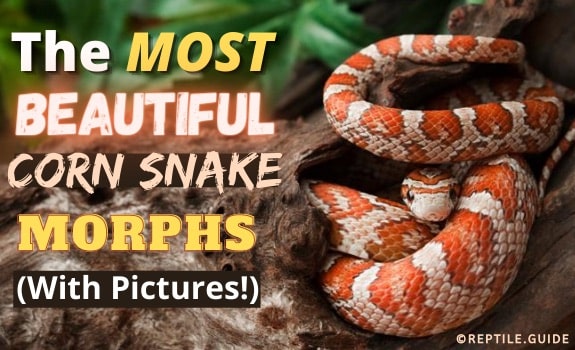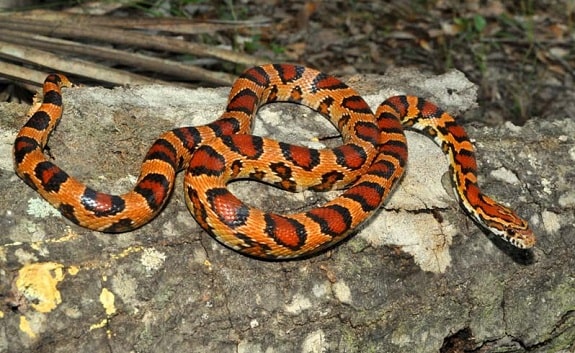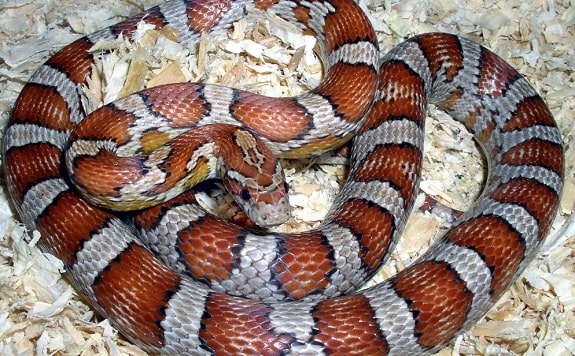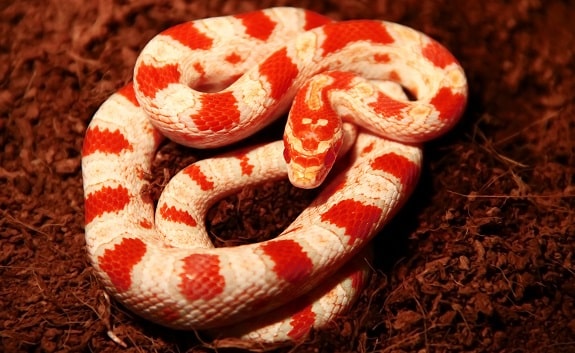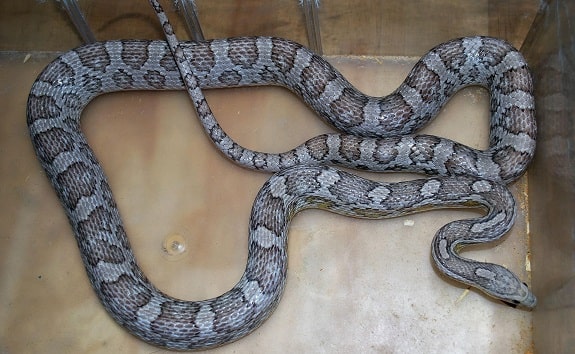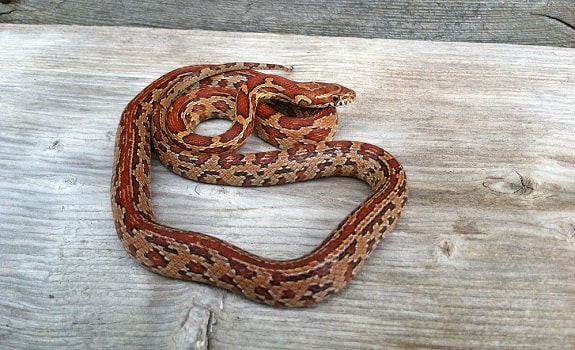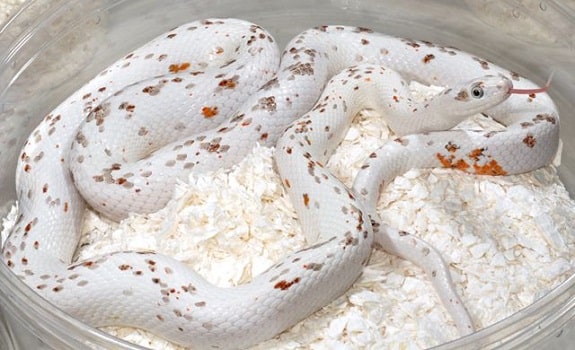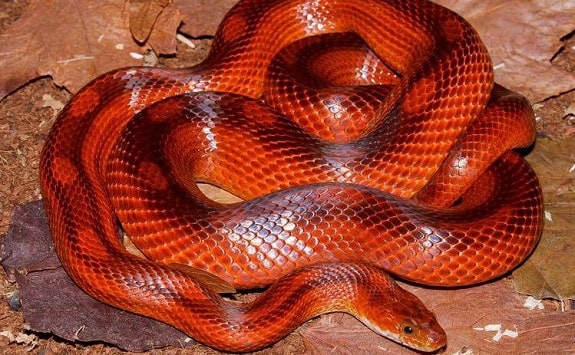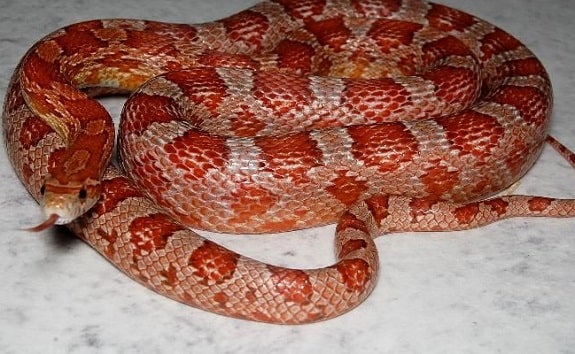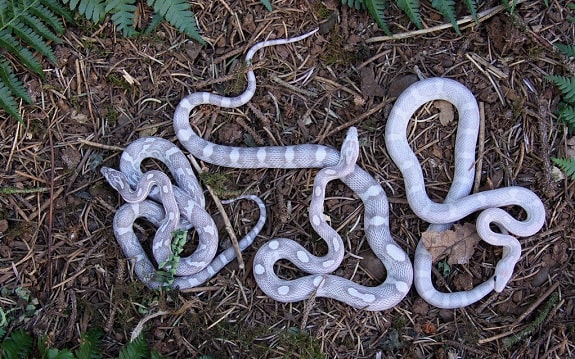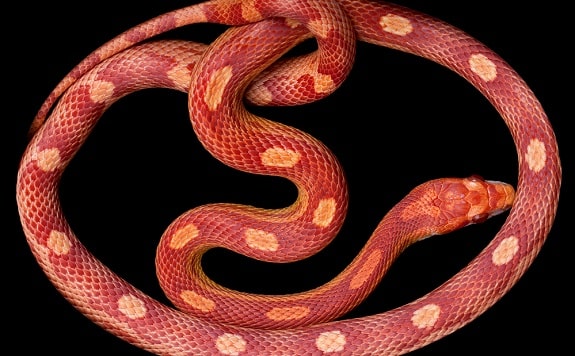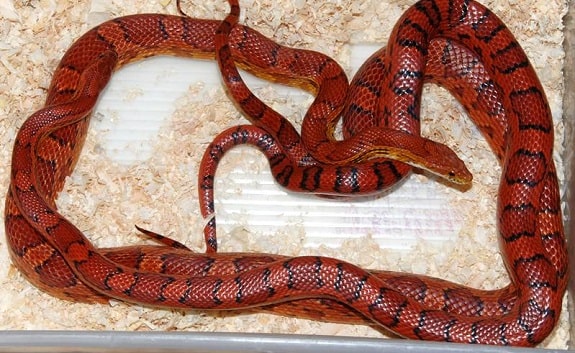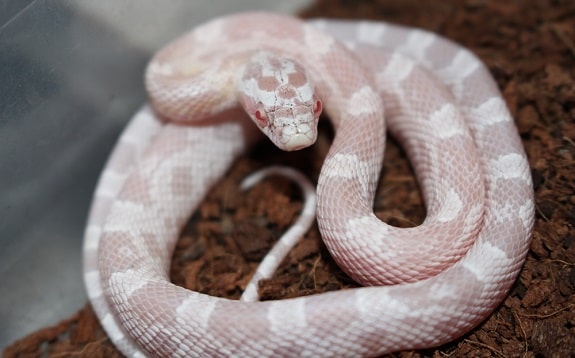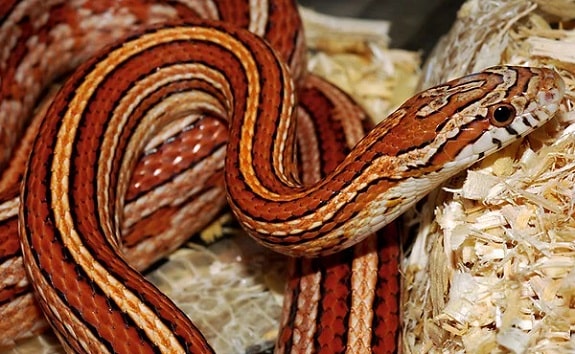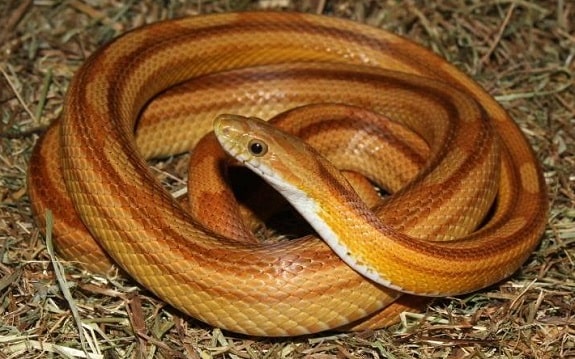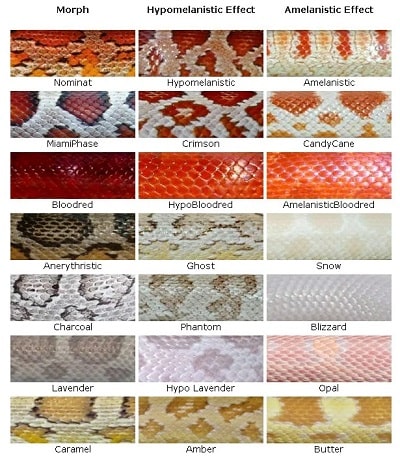Corn snakes (Pantherophis guttatus) are very popular as pets because of their calm nature, manageable size, and simple husbandry requirements.
Thanks to the sheer number of corn snakes (opens in new tab) produced for the pet market, and the fact that they have been selectively bred for decades, a dazzling array color and pattern morphs have occurred.
The sheer number of morphs can seem quite overwhelming at first, but if you keep reading, you might just find the corn snake morph of your dreams.
Let’s start with the basics – localities and single-trait morphs. We’ll also touch on some of the common multi-trait morphs associated with the single traits that are addressed.
In This Article
Normal (Carolina, Classic, Wild Type)
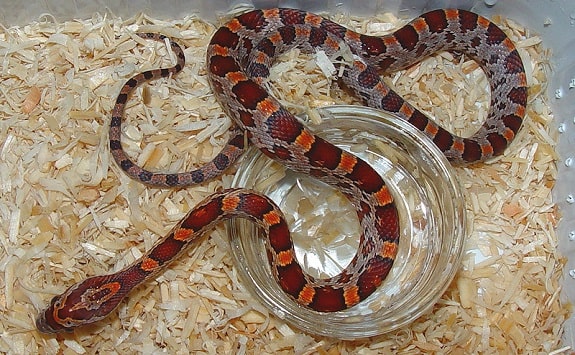
These corn snakes have the appearance of a wild corn snake that you would find in most of their native range – the Southeastern United States.
Normal corn snakes are very easy to find, and the most affordable (non)morph. Like the other common localities and morphs, normal corn snakes are affordably priced at around $40 or more.
Okeetee Locality
Okeetee phase corn snakes are characterized by red saddle markings outlined by pronounced black borders.
This locality is named after the Okeetee Hunt Club of South Carolina, where they originated.
Many hobbyists consider Okeetee corn snakes to be the overall standard in appearance for the species because their markings are striking and readily appreciated.
Thanks to their reputation as the ideal representation of a corn snake, they’re the most common locality on the market.
There are even two well-established strains of Okeetee. Kathy Love’s Okeetees are known for sharp, clean patterns and colors, while Lee Abbott’s Okeetees are famous for their thick black borders and intense colors.
Miami Locality
Miami corn snakes originated from their namesake city of Miami and the surrounding wilderness in South Florida.
Their base color is light silver to gray, with bright contrasting red or orange saddles that are smaller when compared to other corn snake localities’ splotches.
It’s pretty easy to find a Miami phase corn snake at a pet shop or reptile show.
Interestingly enough, they are known to produce larger clutches of smaller neonates than other types of corn snakes.
Keys Locality (Rosy Ratsnake)
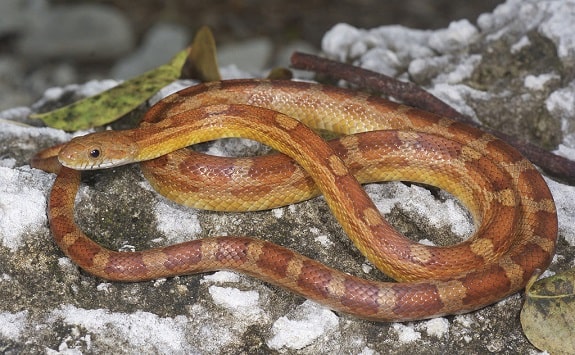
These corn snakes were found initially in their namesake islands – the keys of Southern Florida.
They can be considered a naturally occurring lookalike to hypomelanistic corn snakes, including drastically reduced black pigment, altered belly checkers, and a paler silvery or orange hue.
The difference is so dramatic that they were once classified as their own subspecies, Pantherophis guttatus rosacea or the Rosy Ratsnake.
Albino (Amelanistic, Amel)
The technical, genetic term for an albino corn snake is amelanistic because they lack melanin, which is what causes black coloration in their pattern.
Amelanistic corn snakes are various shades of red, orange, white, and yellow, including their eyes.
Candycane corn snakes carry the amelanism gene, and they were selectively bred using Miami phase corn snakes and hybrids with Great Plains rat snakes.
Some multi-trait morphs created with albino corn snakes include:
- Auratum (Amel x Toffee),
- Blizzard (Amel x Charcoal),
- Butter (Amel x Caramel),
- Fire (Amel x Diffused),
- Lavamel (Amel x Lava),
- Mandarin (Amel x Kastanie),
- Opal (Amel x Lavender),
- Orange (Amel x Buf),
- Snow (Amel x Anery),
- Avalanche (Amel x Anery x Diffused)
It can be challenging to find a “plain” albino corn snake because there are usually other genetics combined with amelanism.
Anerythristic (Anery)
Anerythristic corn snakes can be thought of as the opposite of amelanistic corn snakes.
Instead of lacking black pigment, they lack red pigment. These snakes are varying shades of white, gray, brown, and black.
Like their albino counterparts, it can be challenging to locate a single-trait anerythristic corn snake, but they tend to be sold at an affordable price.
The anerythristic trait is used in the following morphs (and many others!):
- Ghost (Anery x Hypo),
- Granite or Pepper (Anery x Diffused),
- Ice Ghost or Ice (Anery x Lava),
- Snow (Anery x Amel), and
- Avalanche (Anery x Amel x Diffused)
Aztec
This prevalent pattern mutation causes a wild, broken zig-zag pattern in scattered patches, creating a very dramatic appearance.
Corn snake breeders are currently focusing heavily on the Aztec morphs, combining it with many of the color morphs listed in this article.
Palmetto
The palmetto mutation is one of the most popular and striking morphs currently on the market.
It’s the first incomplete dominant trait, meaning that snakes that are heterozygous, meaning to carry one allele for the gene rather than two, look different from normal corn snakes or homozygous palmetto corn snakes, or corn snakes that carry both alleles for Palmetto.
Heterozygous or het palmetto corn snakes look very similar to hypo corn snakes, with brighter reds and oranges and reduced black pigment.
Palmetto corn snakes that are homozygous for the gene are mostly white, devoid of any pattern or color except sparse speckles and splotches.
When this trait is combined with another morph, the splotches take on the pattern and color of whatever other genetic morphs the snake carries.
You can expect to pay a minimum of $350 for a palmetto corn snake, although it’s not uncommon for additional genetic traits to drive the price over $900.
Tessera
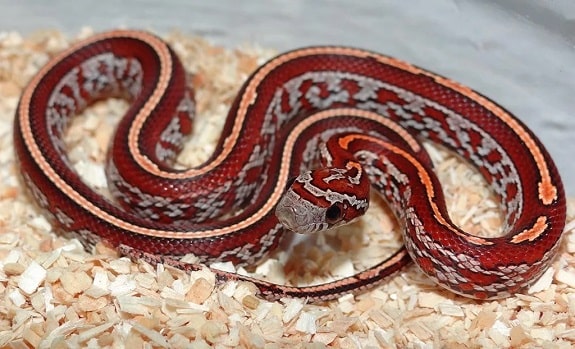
This striking pattern mutation is the first known dominant mutation in corn snakes.
It causes the snake to have a thin, dark-edged dorsal stripe, which squares and pushes the splotched pattern down the animal’s sides.
The pattern has already been paired with many color mutations, and corn snakes displaying the tessera trait can be purchased for as little as $75.
Calico
This unusual genetic trait created corn snakes with scattered white patches and freckles as the snake grows up.
Breeders stopped focusing on this mutation because it was difficult to identify in hatchlings, costly to raise the babies to determine if they were, in fact, Calico, and resulted in unattractive blistering under the white areas that developed.
Customers thought that these corn snakes were unhealthy, and they did not want to pay a large sum of money for a hatchling that might, or might not, be Calico.
Caramel
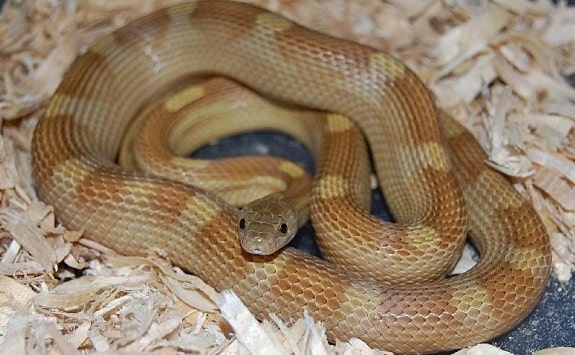
Rather than bright reds and oranges, caramel corn snakes can thank neutral shades for their sweet appearance made up of hues of brown, gold, yellow, and black.
While caramel corn snakes don’t appear to be especially common, they’re one part of other multi-trait morphs like Butter (Caramel x Amel), Honey (Caramel x Sunkissed), and Amber (Caramel x Hypo), and Topaz (Caramel x Lava).
Caramel corn snakes cost around $50.
Charcoal
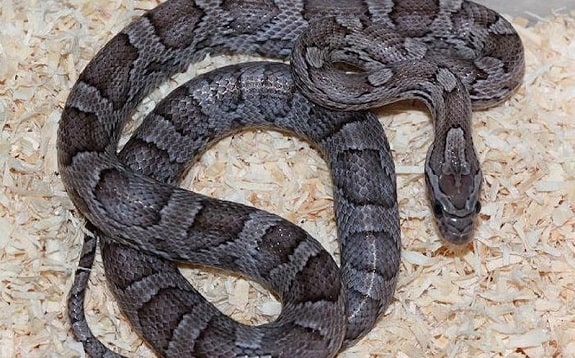
While very similar in appearance to anerythristic corn snakes, this is a genetically separate gene mutation. It’s also known as Pine Island Black Albino or Anerythristic B.
They’re a little harder to find. Still, the trait is utilized in more common morphs like…
- Blizzard (Charcoal x Amel),
- Diamond (Charcoal x Lava),
- Pewter (Charcoal x Diffused), and
- Phantom (Charcoal x Hypo).
Cinder (Ashy, Z)
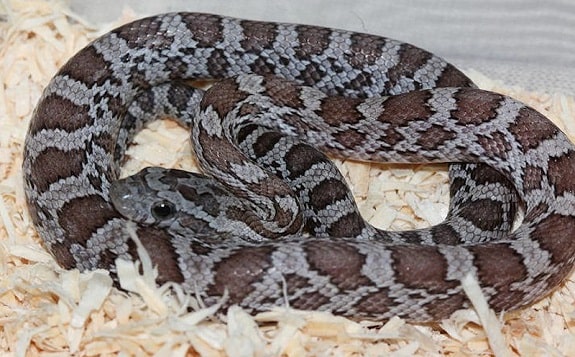
Cinder corn snakes appear similar to anerythristic and charcoal corn snakes when they hatch, but as they mature, they develop red undertones in their markings.
Curiously, they also tend to have a more slender body composition. This morph is slightly more expensive than typical common genetic variations, at around $85 or more.
Diffused
The diffused pattern morph takes away the belly checkers and saddle pattern on the back of a corn snake.
The animal can look normal or strange as a hatchling, but its pattern gradually fades as it reaches adulthood. The result is a uniformly red or orange corn snake with a solid white belly.
Bloodred is the name of a morph of selectively bred snakes with the diffusion mutation, and it’s believed they may have weaker immune systems due to the limited gene pool.
The diffusion gene is also used to create the following:
- Fire (Diffused x Amel),
- Granite or Pepper (Diffused x Anery),
- Pewter (Diffused x Charcoal),
- Plasma (Diffused x Lavender), and
- Avalanche (Diffused x Amel x Anery).
Bloodred corn snakes typically cost around $80, only slightly more expensive than normal corn snakes.
Dilute
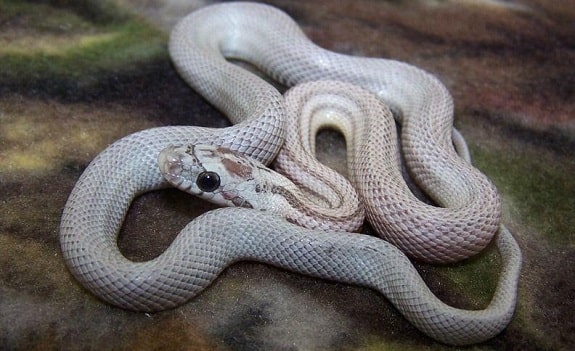
Dilute genetics cause significant fading of the snake’s colors, giving it the appearance of always being “in shed.”
This is one of the newer genetic mutations to occur in corn snakes.
Corn snakes carrying only the dilute mutation don’t typically cost much more than normals, but this gene is usually paired with additional genetic mutations, such as anery, charcoal, and diffused.
Hypomelanistic (Hypo)
Hypomelanism is one of the most common color morphs of just about any species of snake. This mutation simply reduces the black pigment in the snake’s pattern.
Hypo corn snakes can vary from looking mostly normal to almost albino. T
he hypo gene is used to create popular morphs such as Phantom (Hypo x Charcoal), Amber (hypo x caramel), and Ghost (Hypo x Anery).
Hypomelanistic corn snakes are very affordable, costing about the same as a normal animal.
Kastanie (Chestnut)
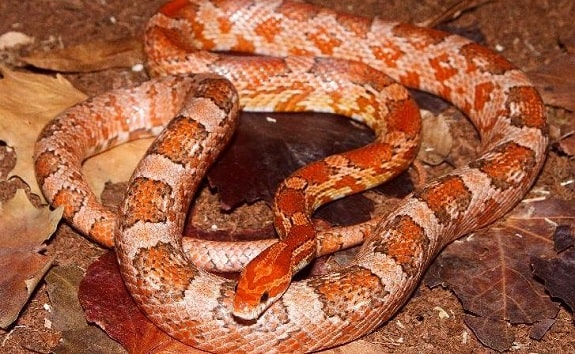
Kastanie is another one of the newer genetic variations to have popped up in captivity.
Hatchlings are duller shades of brown and gray, appearing almost anerythristic, but their color fills in as they mature.
Adult Kastanie corn snakes never appear as vibrant as normal corn snakes. Since it is a reasonably new morph, these little guys sell for around $90 and up.
They’re also used to create multi-trait morphs like Mandarin (Kastanie x Amel) and Persimmon (Kastanie x Lava).
Lava
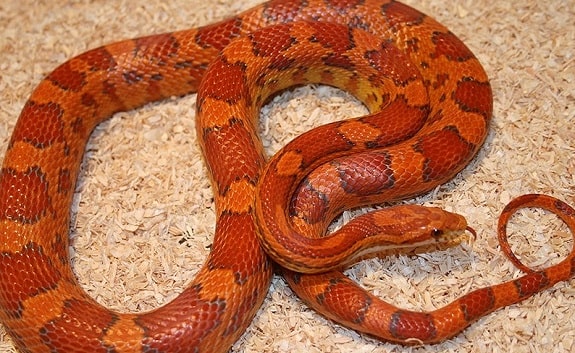
The lava morph looks very similar to the hypomelanistic morph, but it is a different gene.
Where a hypomelanistic corn snake would typically show a minimal amount of black pigment, lava corn snakes appear to have a small amount of grayish-purple instead.
Corn snakes carrying only the lava gene are rather affordable, but they’re also used to create more high-end morphs like Diamond (Lava x Charcoal), Ice Ghost or Ice (Lava x Anery), Lavamel (Lava x Amel), Persimmon (Lava x Kastanie), and Topaz (Lava x Caramel).
Lavender
Lavender is a popular new color morph in corn snakes.
Looks can be deceiving in hatchlings, which appear dull and grey. As these snakes mature, they develop a striking pale lavender hue with silver blotches.
Lavender snakes can be had for as little as $50, but this mutation is often paired with other traits to make high-end morphs like Opal (Lavender x Amel), Orchid (Lavender x Sunkissed), and Plasma (Lavender x Diffused).
Microscale
The microscale gene mutation causes the animal’s scales to be smaller than usual, creating gaps of bare skin between scales and giving the animal an entirely different texture compared to its standard counterparts.
This morph is rare and frequently will cost upwards of $150.
Motley
The motley morph causes the corn snake’s pattern to invert, creating stripes, dashes, and a ladder-like design. The trademark checkered belly pattern is also absent.
This is the most common pattern morph in corn snakes, and it’s usually paired with other color morphs.
Thanks to its prevalence, otherwise normal motley corn snakes can be purchased for quite cheap – as low as $30.
Red Coat
This simple mutation intensifies the red pigment in a corn snake.
It can either create darker, deeper shades of red or, in snakes lacking red pigment like anery corn snakes, it creates darker borders.
This morph is so common that many breeders and sellers cannot distinguish it from the Okeetee locality and the diffused or bloodred morph.
Scaleless
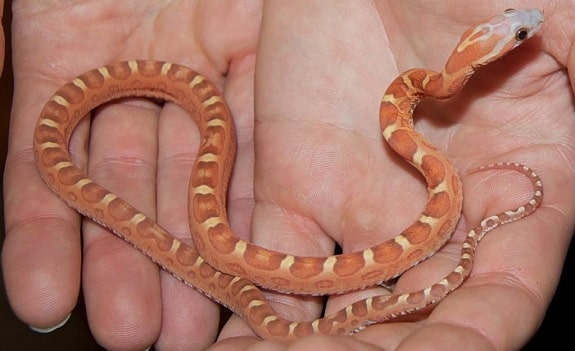
Unlike their namesake, scaleless corn snakes are not entirely scaleless.
All of them have belly scales, but on top, they can vary from having absolutely no dorsal scales to almost all of their dorsal scales with a few patches missing.
Above the snake’s lips and along its spine are the most common locations where they retain their scales.
The absence of scales amplifies the color and pattern of some morphs, so this trait is usually combined with other morphs.
This is a very sought-after morph, and specimens can rarely be purchased for less than $450.
When combined with different traits, like Tessera or Butter, scaleless morphs are arguably the most expensive corn snakes.
These complex morphs can easily cost over ,000.
Strawberry
Strawberry corn snakes appear similar to hypomelanistic animals, but with increased contrast and intense reds.
This trait was recently determined to be different from hypo, so Strawberry genes are already pretty common in captivity and can be purchased for as little as $40.
Striped
The striped trait is a pattern variant that results in three to four lengthwise lines along the corn snake’s body, rather than blotches.
Further variants in the striped pattern may be labeled as cube corn snakes or chaos corn snakes.
The ventral “flint corn” pattern is also absent, similar to the Motley gene. This pattern trait is usually paired with other color morphs, resulting in a wide range of prices.
Sunkissed
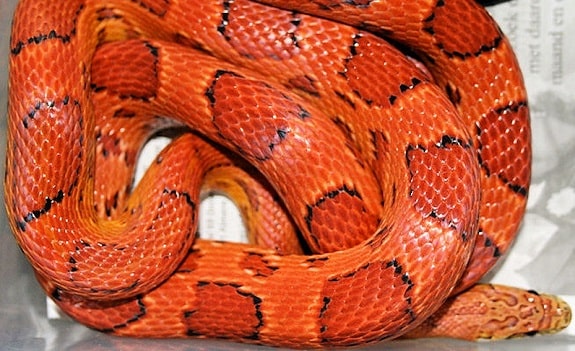
The sunkissed morph is sometimes referred to as Hypomelanistic B. It is, essentially, a hypomelanistic Okeetee corn snake.
There’s usually no way to tell it apart from a normal hypomelanistic, or Hypomelanistic A, corn snake.
These striking snakes cost around the same amount as normals or other common morphs, or you can opt for a morph displaying additional traits like Hazel (Sunkissed x Toffee), Honey (Sunkissed x Caramel), Orchid (Sunkissed x Lavender), or Solar (Sunkissed x Sunrise).
Sunrise
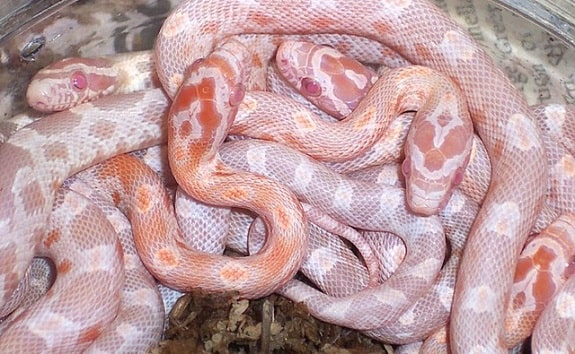
This unique appearance trait is only visually identifiable in hatchling Amelanistic corn snakes and, sometimes, Anerythristic corn snakes.
It causes the neonate to have minimal red coloring, so Amels look like Snows (mostly shades of pink, tan, and yellow), and normals are very dark – almost appearing Anery.
As the snake grows and sheds, the red pigment makes an appearance and fades into a frosted or white-flecked appearance.
This morph is still somewhat rare, and breeders haven’t experimented with it much yet.
So far, the Solar (Sunrise x Sunkissed) and Aurora (Sunrise x Ultramel) morphs have been selectively bred using the Sunrise gene.
Terrazzo
Terrazzo is another pattern mutation and still uncommon in the corn snake morph breeding world.
It gives a unique, grainy striped to almost patternless appearance. Their bellies aren’t checkered.
The gene originated in Keys locale corn snakes, so many terrazzo corn snakes have the associated hypomelanistic-like colors.
These aberrant beauties usually carry a price tag of $150 or more.
Ultra
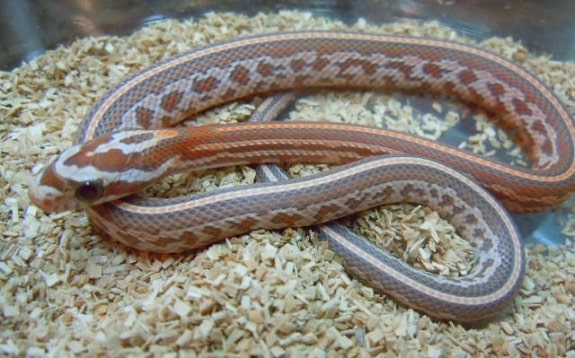
Ultra or Ultra Hypo corn snakes appear quite similar to hypomelanistic corn snakes, sometimes a bit brighter.
Unlike Hypomelanism, the Ultra gene can coincide with Amelanism, which is called Ultramel. Ultra and Ultramel corn snakes start at around $60.
One popular morph that utilizes the Ultra or Ultramel trait is Aurora (Ultramel x Sunrise).
Masque
This trait affects only the head and belly pattern.
It pushes the belly pattern outward into the edges of the ventral scales, which creates a patternless white stripe in the center of the belly.
It also reduces the design on the snake’s head. Not many corn snake breeders work specifically on this morph, but since it is a dominant genetic trait, it’s still fairly common.
Toffee
This new mutation was first discovered in European corn snake collections.
It’s unknown whether it is the same genetic variation as Buf, another European morph. Toffee and Buf corn snakes are both still relatively rare in the US market.
These corn snakes look similar to caramel, but with reduced coloration.
Corn snakes believed to carry the toffee mutation are used to produce Auratum (Toffee x Amel) and Hazel (Toffee x Sunkissed) corn snakes.
On the other hand, corn snakes believed to carry the Buf gene have contributed to the Orange (Buf x Amel) morph.
How Many Corn Snake Morphs Are There?
When it comes to putting a number on the amount of corn snake morphs currently in existence, the sky may as well be the limit.
Furthermore, new genetic combinations and mutations occur every year. Truly understanding corn snake morphs involves basic knowledge of genetics.
The four common wild-type patterns are named based on their place of origin, and over twenty-five single-trait morphs also exist. Beyond that, there are combinations of two, three, four, five, and even six gene mutations to make hundreds of other morphs.
One or more of these traits can also be combined with localities, creating, yet again, additional morphs.
Finally, each genetic trait has two alleles. Most morphs are recessive, meaning that both alleles of a gene must carry the mutation for the snake to display the feature. Some morphs are dominant, meaning the gene only needs to possess one allele.
Meanwhile, incomplete dominant traits like Palmetto create two different phenotypes (appearances), depending on whether the snake carries one allele or both alleles for the mutation.
To perpetuate the sheer complexity of the world of corn snake morphs, there are also hybrids.
Great Plains rat snakes (Pantherophis emoryi) have bred with different corn snake (Pantherophis guttatus) morphs to produce different variations of what is known as a Creamsicle corn snake.
Corn snakes can also breed with California kingsnakes (Lampropeltis californiae) to produce Jungle corn snakes, Pituophis species to create Turbo corn snakes, Brooks’ kingsnakes (Lampropeltis getula brooksi) to create Brook Korn corn snakes, and various species of milk snakes which are known as Pueblacorns, Corndurans, Sinacorns, and more.
All of these hybrids have even proven to be fertile.
Wrapping Up Corn Snake Morphs
Unfortunately, covering the genetics, phenotype (appearance), and interactions of every multi-trait corn snake morph is outside the realm of any single article.
Many of these morphs have simple, combined names, like Amel Cinder for the combination of Amelanistic and Cinder genetics.
On the other hand, some complex morphs displaying as many as five traits have unique names – for example, the Quartz corn snake combines Amelanistic, Anerythristic, Charcoal, and Diffused genes.
Now that you’re equipped with basic knowledge about the primary, single-trait morphs, you’ll be better able to navigate the dazzling and immense world of complex corn snake morphs.
Although any two morphs can look like entirely different species, the care between these unusual specimens remains consistent. You don’t need to worry about a Hypomel corn snake requiring lower humidity, or a Sunkissed corn snake needing higher temperatures.
Surprisingly enough, there aren’t any proven health or lifespan differences among this genetic variation.
Supplied with this understanding, you are genuinely free to pick whichever corn snake morph appeals the most to you, based on appearance, cost, uniqueness, or ease of locating one at your local pet store.
Once you’re done, you’ll need to learn how to care for your new baby corn snake.
Interested in other snake morphs? Check out how the western hognose snake can look and how to care for it!
